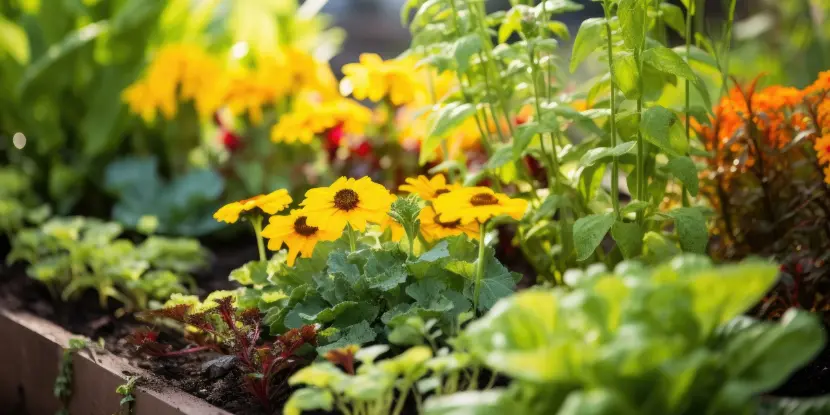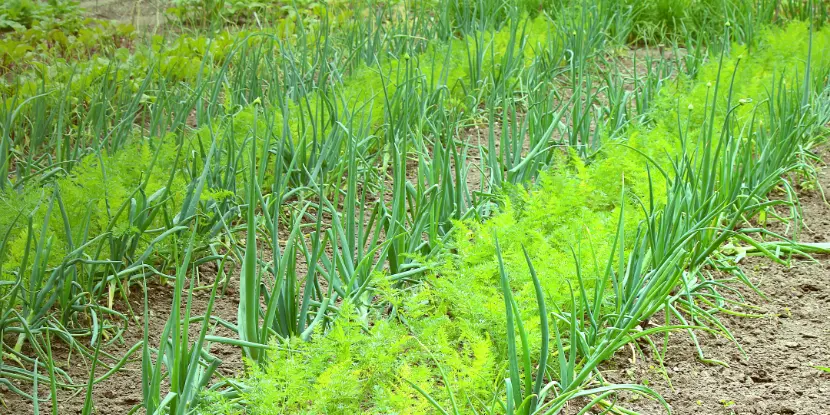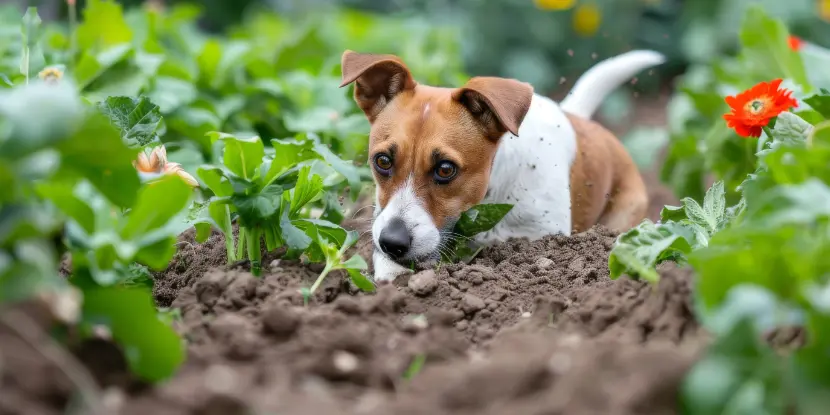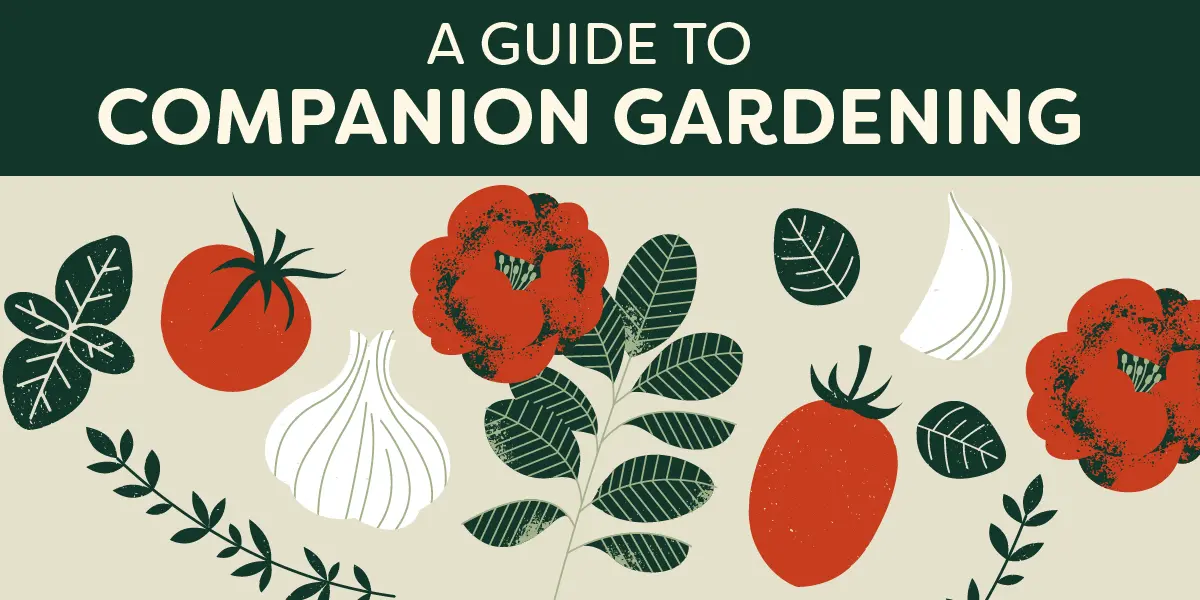Plants have a buddy system.
Certain plants help others grow stronger than they could on their own.
Welcome to companion gardening. Farmers and plant enthusiasts have used this technique for centuries to boost crop yields, improve pest control, and promote overall plant health.
Companion Planting in a Nutshell
Companion planting is the art of growing different plant species in proximity to create a mutually beneficial growing environment. By carefully selecting companion plants, gardeners can optimize space, reduce pest infestations, and raise soil fertility.

Companion planting in a greenhouse.
Historical Roots of Companion Planting
Companion planting traces back to ancient agricultural societies. Indigenous agricultural systems in the Americas, like the Three Sisters method favored by various Native American tribes, exemplify early companion gardening.
When corn, beans, and squash are grown together, the corn provides a natural trellis for beans, which fix nitrogen in the soil, benefiting all three plants. The squash covers the ground, suppressing weeds and holding in soil moisture.
Benefits of Companion Planting
- Pest Control: Certain plants can repel pests, reducing the need for chemical pesticides. For example, planting marigolds alongside food crops deters nematodes and harmful insects.
- Enhanced Growth: Some plant pairings can stimulate each other’s growth. Basil enhances the growth and flavor of tomatoes.
- Improved Soil Fertility: Leguminous plants like beans and peas help fix nitrogen in the soil, enriching the soil’s nutrient content.
- Efficient Use of Space: Growing complementary plants together makes the most of a growing area. Vertical growers like corn support climbing plants like beans.
- Weed Suppression: Ground-cover plants like squash spread out to block sunlight and inhibit weed growth.
- Ecosystem Diversity: Companion planting promotes a diverse garden ecosystem, which attracts beneficial insects and pollinators.
- Reduced Plant Diseases: Some plant combinations lessen the incidence of diseases. Growing chives and garlic can deter fungal infections in susceptible plants.
- Resource Efficiency: Companion planting allows for more efficient water use and reduces the competition for nutrients and sunlight among plants.

A close-up of companion planting technique in action.
Evaluating the Garden Space
- Determine how much sunlight different areas of your garden receive throughout the day. Most vegetables and flowering plants need at least 6–8 hours of sunlight.
- Test the soil for pH levels and nutrients. Healthy soil is crucial for plant growth; knowing its composition will help you select appropriate plants.
- Assess the drainage and moisture levels of your garden space. Ensure that your garden has a reliable water source and good drainage.
- Map out your garden to identify possible planting zones. Consider factors like wind exposure, proximity to structures, and the shape and size of your planting areas.
Common Companion Planting Combinations
Traditional Pairings
- Tomatoes and Basil: Enhances flavor and deters pests.
- Corn and Beans (Three Sisters): Corn provides support; beans fix nitrogen for soil.
- Corn and Squash (Three Sisters): Squash suppresses weeds and maintains soil moisture.
- Carrots and Onions: Onions repel carrot flies.
- Roses and Garlic: Garlic repels aphids and improves the scent of roses.
- Cabbage and Dill: Dill attracts predatory insects that protect cabbage.
- Marigolds and Various Crops: Marigolds discourage nematodes and other pests.
- Lettuce and Radishes: Radishes loosen the soil, aiding lettuce growth.
- Beans and Marigolds: Beans fix nitrogen; marigolds deter pests.
- Cucumbers and Nasturtiums: Nasturtiums deter cucumber beetles.

Companion planting — rows of onion and carrot plants in garden bed.
Modern Innovations
- Tomatoes and Borage: Borage deters tomato hornworms and boosts tomato flavor.
- Strawberries and Spinach: Spinach acts as a ground cover, reducing weed competition.
- Broccoli and Aromatic Herbs: Herbs repel cabbage moths and enhance growth.
- Peppers and Marjoram: Marjoram improves the flavor and growth of peppers.
- Pumpkins and Buckwheat: Buckwheat attracts beneficial insects and enhances pollination.
- Eggplants and Amaranth: Amaranth attracts predatory insects that protect eggplants from pests like aphids.
- Lettuce and Chervil: Chervil deters slugs and enhances lettuce growth.
- Cabbage and Thyme: Thyme helps repel cabbage worms.
- Beets and Kohlrabi: These plants grow well together as they have different nutrient needs and growth habits, reducing competition.
- Radishes and Spinach: Radishes grow quickly and loosen the soil, creating an environment for spinach to flourish.
Top Plants for Pest Control
- Marigolds: Nematodes, aphids, and other pests.
- Basil: Flies, mosquitoes, thrips, and tomato hornworms.
- Lavender: Moths, fleas, whiteflies.
- Mint: Ants, rodents, and cabbage moths.
- Rosemary: Mosquitoes, bean beetles.
- Oregano: Cabbage moths and cucumber beetles.
- Catnip: Mosquitoes and flea beetles.
- Fennel: Slugs and snails.
- Coriander/Cilantro: Aphids, spider mites, and whiteflies.
- Dill: Squash bugs, cabbage loopers.
- Thyme: Cabbage worms and mosquitoes.
- Lemon Balm: Mosquitoes and squash bugs.
- Nasturtiums: Whiteflies, cucumber beetles, aphids.
- Petunias: Tomato hornworms and other pests.
- Onions/Garlic Chives: Carrot flies and other pests.
- Radishes: Cucumber beetles and squash bugs.
- Nigella: Fungal diseases and root-knot nematodes.
- Calendula: Aphids, caterpillars, and whiteflies.

Marigolds nestled between red beet and carrot plants. Marigolds deter nematodes from attacking root crops.
Common Challenges & Solutions
Plant Compatibility
- Some plants don’t grow well together and can stunt each other’s growth or attract pests when planted nearby.
- Solution: Research and carefully plan combinations. Employ tested pairings and avoid planting incompatible species close to each other.
Space Management
- Improper spacing can cause competition for resources and increased susceptibility to disease.
- Solution: Follow recommended spacing guidelines for each plant and consider vertical gardening to optimize space.
Timing
- Different plants have varying growth cycles, and improper timing can lead to one plant overtaking the other.
- Solution: Plan your planting and harvesting schedule meticulously. Use succession planting to maintain continuous growth.
Pest Confusion
- While some combinations repel pests, others might inadvertently attract them.
- Solution: Monitor your garden and deploy additional pest control measures, such as organic insecticides or physical barriers.
Nutrient Imbalance
- Certain plants can deplete the soil of specific nutrients, affecting the growth of neighboring plants.
- Solution: Practice crop rotation and enrich the soil with organic compost and fertilizers that replenish depleted nutrients.

Sorry, no — companion gardening doesn’t involve your dog.
Additional Tips for Successful Companion Planting
- If you’re new to companion gardening, begin with a small area and a few tried-and-true combinations. Expand as you gain confidence and experience.
- Incorporate native plants into your garden. They’re well-adapted to your local climate and soil conditions and require less maintenance.
- Mix different types of plants (flowers, herbs, vegetables) to create a balanced ecosystem that promotes biodiversity and reduces the risk of widespread pest infestations.
- Spend time in your garden daily to observe plant health, monitor for pests, and make adjustments as needed.
- Use organic materials like straw, leaves, or grass clippings as mulch to help retain soil moisture, suppress weeds, and add nutrients to the soil as they decompose.
- Place fast-growing plants like radishes among slower-growing ones. The quick harvest ensures that the slower plants have room to grow once the radishes are harvested.
Conclusion
We encourage you to experiment with different combinations in your garden and observe the outcomes. Each garden is unique, and what works for one may vary for another.
Pay attention to your plants’ health and interactions, and don’t hesitate to make adjustments. Continuous learning and adaptation will lead to a thriving and more resilient plot.
Please share your experiences in the comments section below.
FAQs: Companion Planting
Q: Can I practice companion planting in containers or small spaces?
The same principles apply: give each plant enough space and nutrients to thrive. To maximize your space, consider using vertical gardening techniques and containers of various sizes. Container gardening can also make controlling soil conditions and pests easier.
Q: How do I know if two plants are good companions?
Research plant pairings and understand their needs. Look for information on plants that complement each other regarding nutrient needs, pest control, and growth habits. Experimenting with small sections of your garden can also help you determine the best combinations.
Q: Do flowers play a role in companion planting?
Flowers like marigolds, nasturtiums, and sunflowers attract beneficial insects and pollinators while repelling harmful pests. They can also improve soil health and boost the overall aesthetics of your garden.
Q: What are some good companion plants for tomatoes?
Basil, marigolds, parsley, and chives are excellent companions for tomatoes. Basil helps repel tomato hornworms, while marigolds protect against nematodes. Parsley attracts beneficial insects, and chives deter aphids.
Q: Can I use companion planting to manage soil diseases?
Some plants like marigolds and garlic can reduce soil-borne diseases by releasing natural chemicals that deter pathogens. Crop rotation and adding organic matter can also boost soil health and limit the risk of diseases.
Q: Is there a way to prevent one plant from overshadowing another?
Consider each plant’s mature size and growth habits when planning your garden. Taller plants like corn can provide shade for shade-tolerant plants like lettuce, while vining plants like cucumbers can be trained on trellises to save ground space.
Q: Can herbs be used in companion planting?
Definitely! Herbs like basil, rosemary, thyme, and oregano can effectively repel pests and improve the flavor of neighboring crops.
Q: Are there any plants that should never be planted together?
When grown together, some plants can inhibit each other’s growth or attract pests. For example, keep fennel away from most plants, as it can stunt their growth. Similarly, potatoes and tomatoes shouldn’t be planted together to avoid shared diseases.
Q: How do I manage watering needs with different companion plants?
Grouping plants with similar water needs together makes it easier to manage their demands. This prevents over- or under-watering and ensures that each plant gets adequate moisture. Consider deploying drip irrigation or soaker hoses for efficient watering.

